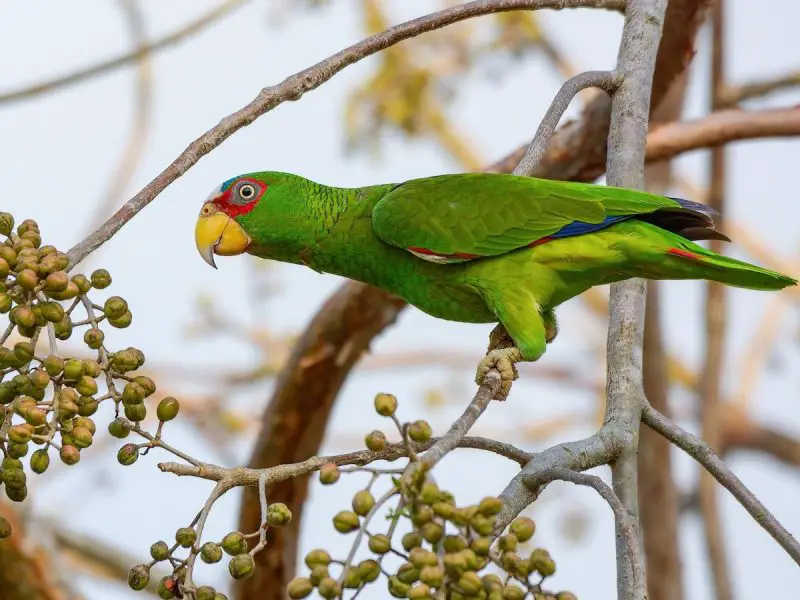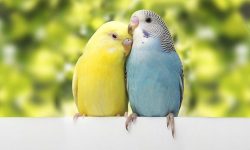Green Amazon Parrots are not your average pets. With dazzling green feathers, the intelligence of a clever toddler, and voices that can mimic human speech with eerie accuracy, these birds have captivated bird lovers for centuries. But behind their charm lies a need for daily attention, mental engagement, and long-term care.
If you’re just beginning your journey with a Green Amazon Parrot or thinking about adopting one, this guide will walk you through everything you need to know to give your parrot a healthy, happy, and enriching life. Let’s dive into the colorful world of these feathered companions and learn how to care for them the right way.

Understanding the Green Amazon Parrot
What Makes This Bird So Unique?
Green Amazon Parrots are striking, highly intelligent birds belonging to the Amazona genus, a group that includes more than 30 different species. Most of them share a vivid green body, stocky build, and curved beak, but their markings and personalities can vary widely. These birds hail from the lush rainforests of Central and South America, where they live in tight-knit flocks and spend their days foraging, vocalizing, and flying across vast distances.
In captivity, their sociable nature remains intact. They’re not just cage birds — they’re companions who want to be part of the daily life around them. It’s not uncommon for them to greet you by name, laugh when you laugh, or call out if they feel left out. Their desire for interaction isn’t optional — it’s essential to their well-being.
What truly sets Green Amazon Parrots apart is their personality. Unlike many birds that tend to remain shy or predictable, Amazons are full of surprises. They’re vocal, expressive, and often mischievous, displaying a remarkable awareness of the world around them. Their ability to mimic human speech is legendary. Some individuals develop vocabularies of 100 words or more and can even use them in appropriate context — a sign not just of memory, but of genuine understanding.
Distinct Personalities Across Species
Within the Amazon family, some species stand out more than others in the pet world. The Yellow-naped Amazon is widely regarded as one of the best talkers. With a strong tendency to bond closely with one person, they are affectionate and loyal, but can also be a little jealous or possessive if not well-socialized.
The Blue-fronted Amazon is energetic, bold, and thrives on attention. It’s not just the blue patch above the beak that makes this bird stand out — it’s their charm, love for music, and theatrical outbursts that make them so entertaining. The Double Yellow-headed Amazon is another vocal prodigy, capable of mimicking entire songs, full sentences, and emotional tones with uncanny precision.
Each parrot, even within the same species, develops a distinct personality. Some are cuddly, some are independent. Some love to be the center of attention, while others are content to sit nearby, quietly observing. Recognizing and appreciating this individuality is key to forming a lasting, rewarding relationship.
A Lifelong Developmental Journey
The journey with a Green Amazon Parrot is long and dynamic. As hatchlings and juveniles, they are curious, flexible, and quick to bond. This is the ideal stage for training, socialization, and introducing new experiences. Young parrots often show eagerness to explore their surroundings, learn sounds, and play with anything that catches their eye.
As they mature into adulthood, their personality becomes more defined. Some may test boundaries, express strong preferences, or develop territorial behaviors. Just like teenagers asserting independence, adult parrots need consistent structure and respectful interaction to stay well-adjusted.
In their senior years — which can be decades down the road — many Amazons mellow out. They may become less active physically but even more affectionate emotionally. Older parrots might require dietary adjustments, joint support, or extra warmth. But with proper care, even a 50-year-old Amazon can remain alert, vocal, and deeply bonded with their human companion.
Emotional Depth and Intelligence
It’s no exaggeration to say that Green Amazon Parrots think and feel on a level closer to humans than many expect. Researchers have compared their intelligence to that of a three- to five-year-old child. They can solve puzzles, understand sequences, and make decisions based on prior experiences. Some learn to respond appropriately to questions, identify colors and shapes, or even demonstrate preferences for music genres.
Emotionally, they’re just as sophisticated. They can show joy, curiosity, anxiety, jealousy, and grief. A parrot that loses a close companion — human or bird — may go quiet, lose appetite, or even exhibit signs of depression. On the flip side, a bird that feels secure and loved will thrive, often becoming more talkative, playful, and trusting over time.
What’s most remarkable is their ability to tune in to your emotions. Many Amazon owners report that their birds react differently depending on their mood — offering comfort when they’re sad, becoming more animated when they’re happy, or even getting “moody” when they’re ignored.
A Natural Communicator
While many people adopt these parrots hoping they’ll talk, it’s important to understand that speech is just one of many forms of communication they use. Amazons are rich in body language. Eye pinning (rapid dilation), feather puffing, tail flaring, beak clicking, wing stretching — all of these are ways your bird expresses thoughts and feelings.
A relaxed parrot may softly grind its beak, gently chatter, or preen in your presence. An excited or alert bird may pace, vocalize loudly, or hop from perch to perch. And a nervous or overstimulated parrot may display stiff posture, hiss, or retreat. Learning to read and respond to these signals deepens your bond and builds mutual respect.
When they do speak, it’s often because they’re mimicking what they hear consistently — but the way they use those words can feel startlingly relevant. A parrot that says “Bye!” when you pick up your keys, or “What are you doing?” when you walk into the room, is clearly more than just an echo.
Understanding your Green Amazon Parrot means more than knowing what they eat or how big their cage should be. It’s about recognizing that you’re sharing your life with a highly aware, emotionally intelligent creature who sees you as part of their flock. When you acknowledge that depth — and respond to it — the relationship becomes something truly extraordinary.
Creating the Ideal Living Environment
Green Amazon Parrots are intelligent, active, and highly social birds. In the wild, they live in tree canopies, enjoying sunlight, fresh air, and constant interaction with their flock. To help your parrot thrive in captivity, you must recreate a home environment that mirrors these natural conditions as closely as possible.

The Cage: Not Just a Space, but a Sanctuary
Choosing the right cage is one of the most important decisions you’ll make as a parrot owner. Think of it not merely as a container, but as your bird’s personal world — a space where it sleeps, eats, plays, and observes the life around it. For a Green Amazon Parrot, the cage must be generously sized to allow full wing extension, climbing, and short flights. Cramped spaces can lead to boredom, frustration, and physical health issues.
Sturdy construction is essential. Parrots are powerful chewers, and flimsy cages can break or become hazardous. Powder-coated or stainless steel cages are ideal because they resist corrosion and are safe for birds to nibble. Horizontal bars are preferable on at least two sides, as they allow the parrot to climb and explore vertically — a natural behavior that supports physical and mental health.
Inside the cage, variety is vital. Provide natural wood perches of differing diameters to exercise the feet and prevent pressure sores. Avoid sandpaper-covered perches, which can irritate or injure the skin. A few well-placed climbing ropes and swings offer enrichment and movement, while toys made of wood, leather, and bird-safe rope allow for chewing, shredding, and problem-solving.
Cage placement within your home matters just as much as the cage itself. Situate it in a room that receives plenty of natural light but isn’t exposed to harsh direct sunlight or cold drafts. Your parrot will want to see and hear the household bustle, but the cage should not be right next to loud appliances, television speakers, or near a window that brings in unpredictable noise or weather.
Green Amazon Parrots are flock animals. They crave social inclusion. Positioning their cage near family activity — such as the edge of a living room or an open kitchen — helps them feel like part of the group. However, ensure they also have quiet time during the day to rest, especially in the early afternoon, when many parrots take naps.
Lighting, Air, and Atmosphere
Light plays a significant role in your parrot’s physical and emotional well-being. Natural light helps regulate their circadian rhythms and encourages healthy hormone cycles. If your home lacks natural daylight, consider using a full-spectrum avian lamp to simulate sunlight. These special lights mimic the UV rays found in nature and support vitamin D synthesis, which is crucial for calcium absorption and strong bones.
Ventilation is equally important. Birds are sensitive to fumes and airborne particles. Never house a parrot in a kitchen with nonstick cookware, as heated Teflon can release toxic fumes. Avoid using air fresheners, scented candles, or cleaning sprays near their space. A well-ventilated room with clean air promotes respiratory health and reduces the risk of infections or allergies.
Humidity can also affect feather and skin condition. In overly dry environments — especially in winter — parrots may experience itchiness or brittle feathers. You can increase humidity by placing a small humidifier near the cage (but not inside), offering daily misting, or allowing regular supervised showers.
Enrichment and a Sense of Security
Mental stimulation is a non-negotiable element of your parrot’s environment. In the wild, Green Amazons spend much of their day foraging, interacting, and investigating their surroundings. A dull, unchanging cage can lead to stress, self-destructive behaviors, and even illness. Rotate toys weekly to keep things interesting. Introduce different textures, colors, and challenges. Puzzle toys that involve pulling strings, opening doors, or removing treats provide hours of focused activity.
Equally important is the sense of safety. Your parrot must feel secure in its territory. Avoid sudden changes in the cage setup or frequent relocations, which can be unsettling. Every bird is different — some adjust quickly, while others need time and patience to accept new objects or spaces. Observe how your parrot reacts to changes, and move at a pace that honors their comfort.
At night, most Green Amazon Parrots benefit from a consistent sleep routine. Covering the cage with a breathable cloth at dusk helps block out distractions and signals that it’s time to rest. The covering also adds a layer of security, recreating the sense of shelter they’d find in a tree hollow in the wild. Aim for 10 to 12 hours of uninterrupted darkness each night to support optimal health and mood.
Creating the ideal environment is about more than just physical components — it’s about emotional awareness, attentiveness, and creating a shared space where your parrot feels included, safe, and mentally alive. When you invest in building a home that meets your parrot’s needs on every level, the result is a bird that sings, explores, trusts, and flourishes.
Feeding and Nutrition
Feeding a Green Amazon Parrot is about more than just providing food — it’s about building health, trust, and longevity through every bite. In the wild, these birds spend a large portion of their day foraging, tasting, exploring textures, and making choices based on what’s available in the season. Mimicking that natural variety and balance in captivity is the key to ensuring your parrot thrives.
The Foundation of a Balanced Diet
The ideal diet for a Green Amazon Parrot should be a carefully curated blend of pellets, fresh produce, whole grains, and occasional healthy treats. Pellets, when chosen from reputable brands and recommended by avian veterinarians, serve as a reliable nutritional base. They are designed to contain the vitamins, minerals, and protein levels your parrot needs on a daily basis, especially when fresh ingredients vary in quality or availability.
But pellets alone aren’t enough. These birds crave variety — not just for taste, but for mental stimulation. Fresh vegetables should make up a large part of their daily diet. Leafy greens like kale, chard, collards, and dandelion are rich in calcium and antioxidants. Vibrant vegetables such as carrots, bell peppers, zucchini, green beans, pumpkin, and squash offer essential vitamins and color variety that parrots naturally gravitate toward.
Fruits, while loved by many parrots, must be treated more like dessert than a staple. Apples (without seeds), bananas, mango, papaya, berries, and melons can be given in moderation. Their high sugar content means they’re best reserved as occasional rewards or for training sessions. Offering fruit in the morning, when energy demands are highest, helps prevent unnecessary sugar storage later in the day.
Whole grains and legumes round out the picture. Cooked quinoa, barley, buckwheat, and brown rice provide long-lasting energy and fiber. Lentils, chickpeas, black beans, and mung beans — especially when sprouted — offer plant-based protein and digestive enzymes that support gut health. These ingredients can be served warm, mashed, or mixed with chopped vegetables to form hearty “parrot salads.”
Seasonal and Age-Based Adjustments
Just like people, parrots benefit from seasonal variety in their meals. In the warmer months, lighter foods with higher water content — like cucumbers, watermelon, and leafy greens — help keep your parrot hydrated and cool. During colder seasons, slightly warmer dishes and root vegetables like sweet potatoes and beets provide comfort and nourishment. Steamed or lightly cooked items can also be more appealing in winter and are easier on the digestive system.
Age also plays a role in dietary needs. Young parrots, especially during weaning, require more fat and protein to support rapid growth and feather development. Adults in their prime need a diet that maintains a lean body while fueling high energy levels and vocal activity. Senior parrots may benefit from joint-supportive nutrients like omega-3s, found in flaxseed or chia, as well as softer foods if their beak strength or chewing ability changes with age.
Safe Foods and What to Avoid
Even the healthiest-looking foods can sometimes pose dangers to parrots. Avocados are toxic to birds due to a compound called persin, which can lead to heart damage and death. Chocolate, caffeine, and alcohol are all strictly off-limits, as they affect a parrot’s nervous system. Onions and garlic contain sulfur compounds that can harm red blood cells, leading to anemia or worse.
Salty, sugary, and highly processed human foods also have no place in a parrot’s diet. Even a single chip or sugary biscuit may throw off their electrolyte balance or cause digestive upset. Bread, dairy, and artificial sweeteners should be avoided altogether. Parrots don’t metabolize fat and sugar the same way humans do, and their organs are easily overwhelmed by excesses.
It’s equally important to pay attention to preparation methods. All produce should be washed thoroughly to remove pesticides and residues. Raw beans must be cooked or sprouted, as certain types contain lectins that are toxic when uncooked. Never cook for your parrot using nonstick pans, as the fumes released by overheated Teflon can be fatal to birds within minutes.
Mealtime as Bonding Time
Feeding your Green Amazon Parrot isn’t just a task — it’s a moment of connection. Many parrots enjoy eating alongside their human companions, especially when they’re given their own bowl at the table or allowed to perch nearby during meals. Sharing safe, healthy bites of your own bird-friendly food (like steamed carrots or brown rice) helps reinforce social bonds and trust.
Using food as a reward during training sessions also strengthens your communication. A tiny cube of apple or a single sunflower seed, given immediately after a desired behavior, becomes a powerful form of positive reinforcement. Over time, this kind of mindful feeding builds not only good habits but emotional closeness.
Parrots also love the process of foraging — discovering hidden treats, solving puzzles to access food, or shredding edible paper to reach a prize. These experiences mimic natural behavior and fight boredom. You can create DIY foraging trays filled with shredded paper, toy parts, and small amounts of favorite snacks hidden inside. Even something as simple as stuffing vegetables into a hollow toy can provide hours of entertainment and exercise.
Water: The Forgotten Nutrient
Fresh water is a vital, yet often overlooked, component of your parrot’s daily care. Water bowls should be changed at least once a day, and more frequently if they become soiled with food, droppings, or feathers. Parrots often dip their food into their water, turning it into soup — which makes frequent cleaning essential to avoid bacterial growth.
Filtered or bottled water is ideal in areas where tap water is treated with heavy metals or chemicals. Avoid distilled water long-term, as it lacks essential minerals. If your parrot seems to drink less during colder months, consider offering warm water to encourage hydration, or increase water-rich foods in the diet.
Feeding your Green Amazon Parrot well is both a science and an art. It requires knowledge, observation, and creativity. But the rewards are immense: a shiny coat of feathers, a playful spirit, a strong immune system, and a bird that lives not just long — but well.
Daily Care and Cleanliness
Keeping the Environment Sanitary
Cleanliness is crucial for both your parrot’s health and your own. Change cage liners daily and remove leftover food promptly to prevent mold or bacterial growth. Food and water bowls should be washed with warm water and bird-safe soap.
Each week, scrub down cage bars, perches, and toys. A monthly deep clean of the entire cage — including every nook and cranny — helps reduce the risk of respiratory infections, especially from mold spores or dried droppings.
Grooming Needs
Parrots naturally preen and bathe themselves, but you can help by providing shallow water bowls for bathing or gently misting them with room-temperature water a few times per week. Regular bathing supports healthy feathers and skin, and it helps remove dust and dander.
Nail trimming may be necessary every few months, especially if your bird doesn’t wear them down naturally through activity. Beak trims are rarely needed if your parrot has enough chew toys and proper nutrition, but if you notice overgrowth, consult an avian veterinarian.
Training and Bonding
Building Trust and Connection
Bonding with a Green Amazon Parrot is both rewarding and essential. These birds don’t warm up instantly; they observe, test boundaries, and respond to consistency. Begin by simply spending time near the cage, talking softly, and offering favorite foods by hand. Over time, the bird will start to associate you with safety and positivity.
Patience is your best tool. Rushing interactions or forcing contact can damage trust and trigger defensive behavior. Let the bird set the pace, and celebrate every small milestone — from taking a treat to stepping onto your hand.
Teaching Tricks and Communication
Training sessions should be short, upbeat, and consistent. Begin with simple commands like “step up,” and reinforce success with praise, a scratch on the head, or a small treat. Once your parrot understands the basics, you can move on to more advanced tricks or vocabulary.
Speech training is most successful with repetition and context. If you say “good morning” every day at breakfast, your parrot may one day say it first. Keep in mind that not all individuals will talk, but even non-speaking parrots can learn cues, respond to tone, and develop rich, expressive body language.
Preventing Behavioral Issues
Parrots that lack stimulation or attention can develop problematic behaviors. Screaming, biting, or feather destruction often signal that something in the environment needs to change. These aren’t signs of a bad bird—they’re calls for help.
Make sure your parrot has regular interaction, space to exercise, mentally engaging toys, and a predictable routine. If undesirable behavior does arise, avoid punishment. Instead, redirect the behavior, offer alternative activities, and reward calm, appropriate actions.
Positive reinforcement is powerful. Parrots remember kindness and consistency—and they will often rise to the expectations you gently and patiently set for them.
Exercise and Mental Enrichment
Green Amazon Parrots are naturally active. In the wild, they fly long distances, forage, and interact constantly with their flock. In captivity, a sedentary life can lead to obesity, muscle atrophy, and even depression.
Allow your parrot time outside the cage every day in a bird-proofed room. Provide climbing stands, ladders, and ropes that encourage movement and play. Flight, if allowed, offers tremendous benefits, but even flapping and climbing help keep the body strong.
Mental stimulation is just as important. Teach new tricks regularly. Hide treats in puzzle feeders. Change up their toy selection every week. Introduce music, nature videos, or interactive games. These challenges help prevent boredom and keep your parrot alert and curious.
Monitoring Health and Veterinary Care
A healthy Green Amazon Parrot is energetic, vocal, and engaged. Changes in behavior, appetite, or droppings can signal illness. Look out for signs like puffed-up feathers, labored breathing, watery eyes, lethargy, or excessive sleeping. Because birds mask symptoms, acting quickly is critical.
Establish a relationship with a certified avian veterinarian. Schedule annual checkups, even if your bird appears healthy. These exams often include blood work and physical evaluations that can catch issues before they become serious.
Good health begins at home, though. Clean housing, proper nutrition, daily exercise, and emotional care go a long way in preventing disease.
Communication and Social Needs
Green Amazon Parrots are among the most talkative bird species. While not every individual will become a fluent speaker, many learn dozens of words, mimic household sounds like ringing phones or laughter, and even sing along to music.
But beyond speech, they communicate constantly. Fluffed feathers, pinned eyes, tail flicks, and beak grinding all tell you how your parrot feels. Learning their body language is key to building a strong relationship.
Vocalizations can be loud, especially at dawn or dusk. To manage noise levels, keep a consistent routine, provide ample stimulation, and avoid accidentally rewarding screaming by rushing to their side. Parrots are quick learners—and they’ll repeat behaviors that earn your attention.
Emotional Wellbeing and Long-Term Bonding
These birds are incredibly social and emotionally complex. In the wild, they form close bonds with mates and flock members. In captivity, they see you as their flock. Leaving a parrot alone all day can lead to loneliness and behavioral issues.
Daily interaction, affection, and a stable environment help your parrot feel safe and loved. Many enjoy sitting on your shoulder while you work, chatting from across the room, or snuggling close during quiet evenings.
Over time, your Green Amazon Parrot will become more than a pet. It will be a companion with moods, preferences, and a personality all its own. Recognizing and nurturing that individuality is the key to a truly rewarding bond.
Conclusion: Sharing Life with a Green Amazon Parrot
Caring for a Green Amazon Parrot is not just a hobby—it’s a lifelong journey built on trust, learning, and love. These brilliant birds bring endless color and chatter into your life, but they also ask for your time, your patience, and your unwavering presence. With the right home, diet, mental stimulation, and compassionate handling, your parrot won’t just survive—it will thrive.
This guide is just the beginning. The rest of the story unfolds every day as you and your feathered friend grow together, build routines, and develop a bond like no other. If you’re ready to commit, the rewards are profound: intelligent interaction, loyal companionship, and a bird that may very well become your most fascinating friend for decades to come.
So open your heart, extend your hand, and begin the beautiful, lifelong adventure of sharing your world with a Green Amazon Parrot.






